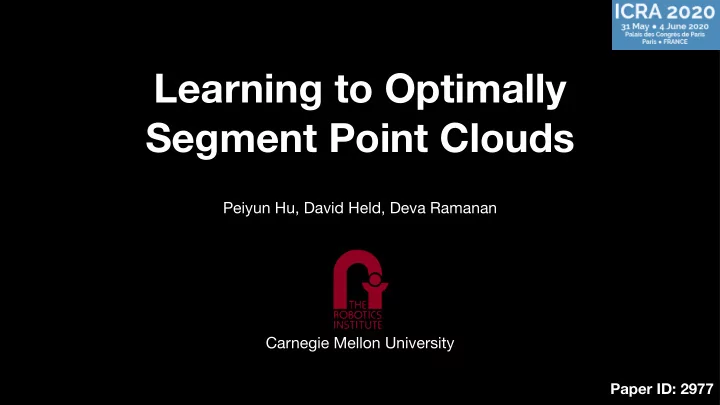

Learning to Optimally Segment Point Clouds Peiyun Hu, David Held, Deva Ramanan Carnegie Mellon University Paper ID: 2977
Raw LiDAR Scans Today, most autonomous vehicles perceive the world through LiDAR point clouds.
Map-based Preprocessing They often use pre-built maps to first filter out points from the background, then run clustering on points from the foreground to obtain object-level perception. *We focus on a limited field of view in this work.
Object-level Perception However, it is often hard to set the right hyper-parameters for clustering. For example, Euclidean Clustering with a large distance threshold tends to under-segments pedestrians. *Colors flicker because the algorithm does not track objects across time.
Object-level Perception And Euclidean Clustering with a small distance threshold tends to over-segments vehicles. *Colors flicker because the algorithm does not track objects across time.
No One-Fits-All Solution The best distance threshold often varies from scenario to scenario. = 2.0m = 1.0m ε ε = 0.5m = 0.25m ε ε *Colors across parameters do not indicate correspondence.
A Hierarchical Perspective Segmentations with di ff erent thresholds form a hierarchy, where nodes represent segments. = 2.0m = 1.0m = 0.5m = 0.25m ε ε ε ε
Learning Objectness Models We learn a model to predict an objectness score for each segment in the hierarchy. Bad 0.1 0.9 PointNet++ ( Qi et al. , NeurIPS’17) Good
Objectness How well a segment overlaps with ground truths.
Searching for Optimality Given a hierarchy of segments with scores, we search for the optimal segmentation. Bad Good
Optimal Worst-case Segmentation We propose an e ffi cient algorithm that produces optimal segmentation under this definition. the worst segment score segmentation score Bad defines Good
Average-case Segmentation We also propose an e ffi cient algorithm guided by average-case score. average local segment score global segmentation score Bad defines Good
Quantitative Evaluation Protocol: compute the percentage of objects that are under-segmented and over-segmented. Assumption: output is a valid partition. 1 [ | C i * ∩ C gt 1 [ | C i * ∩ C gt L L l | l | U = 1 O = 1 ∑ ∑ < τ U ] < τ O ] | C gt L | C i * | L l | l =1 l =1 2 under-segmented pedestrians 1 over-segmented car Held et al., RSS’15
Segmentation Errors (1) As distance threshold increases, more under-segmentation and less over-segmentation. (2) Our adaptive algorithm significantly outperforms each single-parameter baseline. (3) We also plot the lower-bound errors for the search space, showing room for improvement. CC(0.25m) CC(0.5m) CC(1m) CC(2m) Ours(min) Ours(avg) CC(*) 1 92% 91% 0.75 68% 65% 0.5 35% 0.25 28% 25% 23% 19% 17% 13% 13% 9% 9% 8% 8% 1% 3% 5% 6% 5% 0 Under Over Total
No One-Fits-All Solution The best distance threshold often varies from scenario to scenario. = 2.0m = 1.0m ε ε = 0.5m = 0.25m ε ε *Colors across parameters do not indicate correspondence.
Algorithmic Output Our algorithm can adaptively choose the best distance threshold for each scenario.
https://cs.cmu.edu/~peiyunh/opcseg
Recommend
More recommend